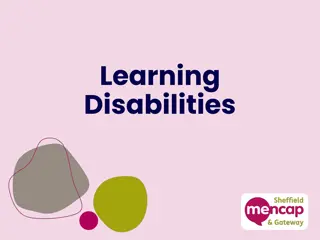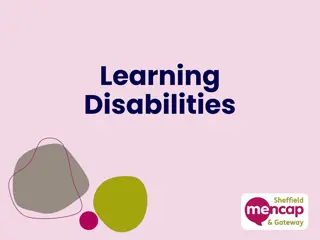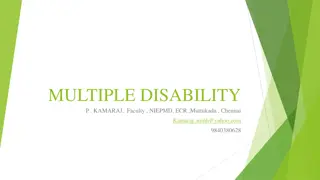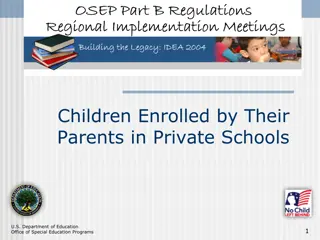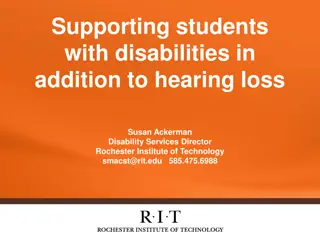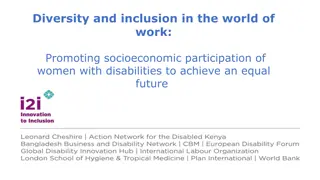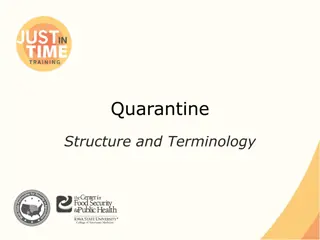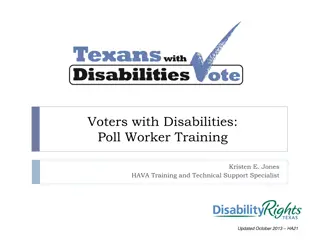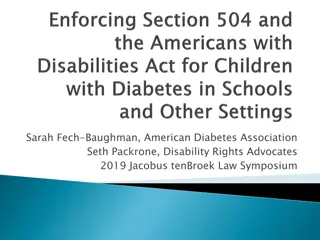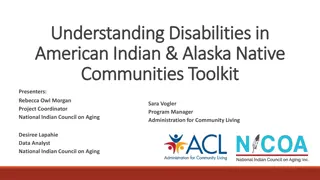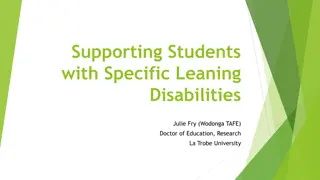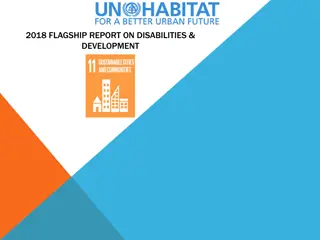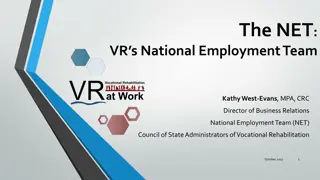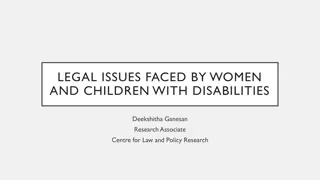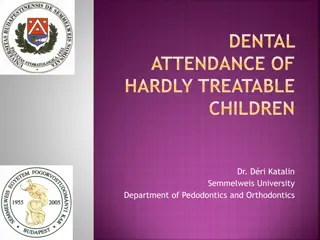Understanding Learning Disabilities: Types, Causes, and Terminology Changes
Explore the various types and causes of learning disabilities, including Down syndrome and genetic, inherited, metabolic, and intrauterine factors. Learn how terminology has evolved over time to promote respectful language and understanding. Gain insights into models of care and national frameworks aimed at supporting individuals with learning disabilities.
Download Presentation

Please find below an Image/Link to download the presentation.
The content on the website is provided AS IS for your information and personal use only. It may not be sold, licensed, or shared on other websites without obtaining consent from the author. Download presentation by click this link. If you encounter any issues during the download, it is possible that the publisher has removed the file from their server.
E N D
Presentation Transcript
Health & Social Care Health & Social Care Knowledge Knowledge Organiser Unit 9: Supporting People with Learning Disabilities Organiser
LO1: Know the types and causes of learning disabilities Models of care for learning disabilities In 2015 a large group of organisitations (NHS England, the Local Government Association, the Association of Directors of Adult Social Services, the Care Quality Commission, Health Education England and the Department of Health) published a new draft national framework to improve care for people with LDs. Shift away from hospital care to community-based setting Defined what good service was for people with learning disabilities should look like with 9 key principles. How and why terminology changes over time Labels and terminology have changed over time as people realised that some names were offensive. The terms used within legislation were influenced by the language of the time. These may not have been seen as offensive at the time but became so because people used some of the terms as derogatory (to insult people). Individuals with disabilities became stereotyped with a negative image. Although it is important to know this historical context, only currently approved terms should be used in any setting. Definitions Use and misuse of terminology Organisation Definition Learning disability Learning difficulty Mencap A reduced intellectual ability and difficulty with everyday activities - for example household tasks, socialising or managing money - which affects Refers to a condition where an individual s ability to learn, understand and communicate is impaired. Often used in educational settings and refers to individuals who have specific problems with learning as a result of either medical, emotional or language problems but this does not affect the overall IQ of an individual and they do not have a significant general impairment in intelligence. NHS A learning disability affects the way a person understands information and how they communicate. This means they can have difficulty: understanding new or complex information learning new skills coping independently IQ classifications are the only way of classifying learning disabilities in the UK but the language is now seen as outdated. 50 70 mild learning disability 20 35 severe learning disability Department of Health A significantly reduced ability to understand new or complex information, to learn new skills (impaired intelligence), with a reduced ability to cope independently (impaired social functioning), which started before adulthood, with a lasting effect on development. 35 50 moderate learning disability below 20 profound learning disability. All these definitions have a common theme of lack of intellectual ability and impaired ability to cope with the tasks of daily living. Terminology changes over time terms within legislation are influenced by the language we use and some terms have become derogatory in our language.
LO1: Know the types and causes of learning disabilities Disability Description Causes of Learning Disabilities Down s syndrome Genetic condition caused by the presence of an extra chromosome 21 in the body s cells. It is not a disease and is not usually inherited. Everyone born with Down s syndrome will have a degree of learning disability, but the level of disability will be different for each individual. Inherited from parents: genes are passed from the parents that affect the development (e.g., Fragile X) Presence of extra or missing chromosome: Chromosomes make up genetic blueprints. Usually we have 23 pairs, but sometimes there can be an abnormality that can lead to an extra or missing chromosome. (e.g., Down s syndrome) Metabolic: Our metabolism controls chemical changes in the body. Any changes in this can cause issues with the breakdown of chemicals in our body which can lead to learning disabilities (e.g., PKU) Intrauterine: something happens to the fetus while in the uterus. Lack of oxygen in the womb Mother illness during pregnancy Use of drugs and alcohol in pregnancy Perinatal/neonatal: Learning disabilities may occur as a result of complications during or soon after birth e.g., oxygen supply is significantly interrupted Postnatal: Some childhood infections can affect the brain (encephalitis and meningitis). Social and environmental aspects can also play a role (poor diet, housing, malnutrition, child abuse, severe head injury)cv Rett syndrome A rare condition that affects the development of the brain. It can cause severe physical and mental disability that begins in early childhood. Parents tend first to become aware of the condition when their child s development slows. Williams syndrome A genetic condition that is present at birth; it is characterised by medical problems, including cardiovascular disease, developmental delays and learning disabilities. Most people with Williams syndrome will have mild to severe learning disabilities and cognitive challenges. Fragile X syndrome is a genetic condition and is the most common known cause of inherited learning disabilities; it is also the most common known genetic cause of autism. Learning disabilities occur in almost all boys with Fragile X, to differing degrees. Girls usually have milder learning disabilities than boys. Physiological conditions may be misinterpreted as learning disabilities Specific learning difficulties Cerebral palsy: affects muscle control and movement. It is usually caused by an injury to the brain before, during or after birth. People with cerebral palsy may have difficulties in controlling muscles and movements as they grow and develop. This affects walking, speech and often swallowing. Autism: learning disability, autism is a lifelong condition. Someone may have mild, moderate or severe autism, so it is now referred to as autism spectrum disorder (ASD). Autism is not a learning disability, but research suggests that around half of people with autism may also have a learning disability. Asperger s syndrome is a form of autism which also causes communication and emotional problems. However, people with Asperger s syndrome often have fewer problems with speaking and are less likely to have a learning disability. Global development delay: when a child takes longer to reach certain developmental milestones than other children their age. SpLDs affect the way information is learning or processed. They are neurological and usually run in families and occur independently of intelligence They often have a significant impact on education. Dyslexia: difficulty in processing words correctly and problems with memory, time perception, organisation and sequencing. Dyspraxia: affects coordination, time management, planning and organisation Dyscalculia: Difficulty with mathematical concepts, symbols and simple numbers. ADHD: inattention, restlessness, impulsivity, erratic, unpredictable and inappropriate behaviour, inappropriate comment, interrupting excessively and unintentionally aggressive.
LO2: Understand the difficulties that may be experienced by individuals with learning disabilities Potential difficulties and their impact Communication Environmental Economic Attitudes Physical Intellectual Mild Delayed language Physical disability Transport-travel information slower that typical in all areas of development. Able to learn practical life skills May result from varying underlying disorders or brain damage Cost of leisure activities Comes with mobility issues and issues with fine and motor skills Prejudice Info is often presented in a way that is hard to understand Difficulty in using language Problems with gait Moderate Issues with walking and balance can cause danger of falls and injuries Lack of confidence using transport Cost of transport Stigma noticeable development delays. Difficulty in information processing Difficulty in expressing ideas clearly and may be hard to understand Personal safety judgement Posture Severe Impaired speech Living conditions Postural issues can cause severe pain, pressure sores etc. Cost of care Fear considerable delays in development. Little ability to communicate or understand info Inability to produce speech sounds No choice about where they live or who they live with Want for a more independent life Not understanding written information Profound Lack of Movement understanding significant delays in development. Extremely limited communication Access to buildings and leisure Discrimination Lack of choice
LO2: Understand the difficulties that may be experienced by individuals with learning disabilities Ways of overcoming potential difficulties Social Inclusion Financial Assistance Advocacy Person-centred planning, as well as modernising day services to help encourage independent living and social skills for forming meaningful relationships with different groups of people. Speaking up for someone.. People with learning disabilities may need an advocate because they are at risk of being ignored. Making sure their voices are heard and that they can make their own choices. Empowerment Wide range of disability related financial support available. Personalised budget, financial assistant with housing adaptions or transport Active Participation Treating the person as an individual . Recognising their right to participate in every day activities etc. as independently as possible. The individual is an active partner is an active partner in their own care and support. Positive Images People with learning disabilities need to have equal participation in education, employment, social and leisure pursuits to challenge negative stereotypes. Positive portrayal in the media is important too. Gives an individual more power or control over their lives by giving them real choices and encouraging them to develop confidence in their own decision making. Access to services and assessment Accessible information Most local authorities provide a variety of services to support individuals with learning disabilities. Their teams include health and social care specialists with a variety od roles to help offer support for a variety of individual needs Mencap commissioned a guide in partnership with the Department of Health to ensure people commissioning services would meet communication needs of individuals with learning disabilities. It is also useful for anyone working or caring for people with a learning disability (Make it Clear Mencap)
LO3: Be able to support individuals with learning difficulties to plan care and support Support Services Organisation Definition Local Mencap support individuals with a learning disability and their families and carers in local communities. Each local group is different and its services can include anything from providing advice and information for family carers, running supported living services or organising social events. Down s Syndrome Association Helps individuals with Down s syndrome to live full and rewarding lives Runs a helpline and provides information about all aspects of living with Down s syndrome. Advises new parents or anyone with questions as well as promotes and facilitates information exchange between members through various groups. Phab clubs Promote and encourage individuals of all abilities to come together on equal terms, to achieve complete inclusion within the wider community. It supports a network of clubs for all age ranges, offering activities and holidays that members can share and enjoy together while promoting and encouraging self-confidence and independence in young people of all abilities. Residential Care Most residential homes for individuals with learning disabilities are designed and adapted to individual needs. Often residential care is provided in small units so there is a family need to them. Short term breaks / respite care Short break for families caring for relatives with disabilities. Provides a break for carers and individuals from usual routines to improve the quality of their lives and support their relationships Special Educational Needs provision in schools Most children will get support they need from their local school, but some support needs a special statement drawn up for them Educational Health and Care Plan (EHCP). Supported living Enables individuals to live in their own home. They may share with others or individually and gain support for some of their daily tasks to support independent living. Employment services The most common tool used to support people with a learning disability is called supported employment.
LO3: Be able to support individuals with learning difficulties to plan care and support Initial Assessments Specialist Assessments Some conditions are easier to diagnose than others. Some may be told that their child has a global learning delay which means that they will take more time to reach milestones. Sometimes getting diagnoses is a problem GP will refer to a paediatrician who will assess their condition Person Centred plans Helps an individual plan all aspects of their life, ensuring they remain central to the creation of any plan. Individual rmailns in control of any plan made.. Individual learning plans / Individual educational plans Designed for children with SEN needs to help them gets the most out of education. Builds on the curriculum that a child with learning disabilities is following, setting out strategies used to meet their needs. Education and health care plan A needs assessment with involvement from different professional sin education, health and social care. The local authority reviews assessment and decides whether ECHP is needed or not. Multi-disciplinary approach Involves a range of professionals from different specialities, from several organisations, working together to deliver comprehensive care for an individual. Safeguarding Social care plays an important role in helping individuals with care and support needs to live full lives. This includes preventing abuse, minimising risk without taking control away from individuals, and responding proportionately if abuse or neglect has occurred. Legislation Referring to Learning Difficulties NHS and community Care Act (1990) Introduced a requirement for local authorities to help vulnerable adults remain in the community, preventing or delaying admission to institutional care. The Act requires local authorities to carry out assessments of people who appear to be in need of community care services, and to arrange packages of care. Most social services departments operate a set of eligibility criteria that define who is eligible for an assessment of need as well as support from services. The assessment process has largely been subsumed under the Single Assessment Process. Mental Health Acts (2007) Power to enforce compulsory detention when necessary for safety of their own health or others. Ensure patients receive the care they need to protect them and public from harm, support modernised services and strengthens patient safeguards Mental Capacity Act (2005) Puts into place a process to decide whether someone has mental capacity to make their own decisions about their care and treatment. Equality Act (2010) Protects people from discriminatory practice on the basis of 9 main principles age, disability, gender reassignment, pregnancy and maternity, race, religion/belief, sex and sexual orientation. Human Right Act (1998) The legal framework for human rights requires that health and social care workers, alongside other providers of public services, must respect the dignity of people using services. Children and Family's Act (2014) Sets out requirements that education, health and care services should work together to provide joined-up support across all areas of a child s or young person s life. The Care Act (2014) Aims to keep the individual at the centre of their own care to meet their specific needs, thereby ensuring their wellbeing
LO3: Be able to support individuals with learning difficulties to plan care and support Guidance Can be statutory (legally enforceable) or non-statutory. Provides advice and assistance for putting provisions of law into actions. Statutory guidance must be followed unless there is a valid reason not to do so. E.g. Code of Practice under The Mental Health Capacity Act is statutory guidance. Non-statutory guidance is more advisory in nature and may be in an informal form (e.g. leaflet). Policies All health and social care organisations have written policies in place to protect staff and service users. These are based on legislation and ensure staff and individuals follow the same principles of care. Policies should be drawn up with the input of all concerned so that they feel empowered E.g. if there is an issue with safeguarding and a staff member is unsure what to do they should check their safeguarding policy. Charters A series of pledges giving organisations clear frameworks for improving practice. They help define the quality of care that service users expect. Codes of Practice A set of written rules to explain how people in a certain profession should behave. Most professional bodies have a code of practice, demonstrating advice and guidelines for delivering quality care and describing standards of conduct. The White Paper: Valuing People - A New Strategy for Learning Disabilities for the 21st Century Valuing People (2001) sought to underpin the government s vision for people with learning disabilities by confirming four key principles of rights, independence, choice and inclusion. Key elements included: An end to long-stay hospitals. A five-year programme to modernise local council day services. A new national learning disability information centre and helpline in conjunction with Mencap. A national forum for people with learning disabilities. Specialist local services for people with severe and challenging behaviour, and integrated facilities for children with severe disabilities and complex needs. An extension of eligibility to direct payments, a scheme which allows service users to choose and purchase their own care. Fair Access to Care Services Fair Access to Care Services (FACS) guidelines were introduced by the government in 2003 as a means of providing local authorities with a common framework for determining individuals eligibility for social care services and addressing inconsistencies in outcomes across the country. Four categories: critical, substantial, moderate and low Some local authorities will only offer help if the individual is in the critical or substantial categories, but this does vary across the country even though this system was meant to iron out inconsistencies in outcomes. No Secrets 2000 on protection of Vulnerable Adults Local authorities are bound to follow No Secrets guidance unless under exceptional circumstances. It requires the identification of who is at risk and why. It requires local authorities to set up a multi- agency group led by social services but also involving NHS bodies and police to develop joint codes of practice and ways of working together. Multi-agencies should also develop policies for responding to allegations as well as carrying out investigations balancing confidentiality with information sharing. Death by Indifference (Mencap, 2007) This report sets out why Mencap believes there is institutional discrimination within the NHS, and why individuals with a learning disability get worse health care than non-disabled people. It presents the stories of six people who they believe have died unnecessarily through doctors and nurses treating these individuals while failing to understand the medical needs or appreciate the seriousness of their conditions that led to their death.


